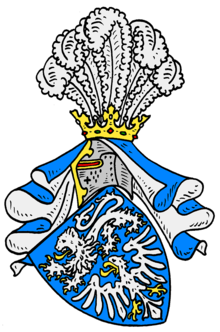- Duchy of Merania
-
The Duchy of Merania (also Meran, Merano, or Meranie, German: Herzogtum Meranien) was a short-lived Estate of the Holy Roman Empire existing from 1153 until 1248. It was also called the Duchy of Dalmatia as it covered the northern Dalmatian seacoast. The name "Merania" (not to be confused with Tyrolean Meran) derives from Latin: mare (sea), probably referring to the coastal strip on the Kvarner Gulf of the Adriatic Sea west of Rijeka, which belonged to the Imperial March of Istria.[citation needed]
Contents
History
The duchy was established as an Imperial fief by Frederick Barbarossa, elected King of the Romans since 1152. A scion of the Swabian House of Hohenstaufen, he had succeeded his uncle King Conrad III of Germany, who had to ward off his Welf rival Duke Henry the Proud, who finally was stripped off his Bavarian duchy in 1138. Frederick himself aimed at a settlement with the Welf dynasty, and at the 1154 Reichstag in Goslar re-instated Henry the Proud's son Henry the Lion as Bavarian duke. Henry nevertheless only regained a rump-state: the Bavarian March of Austria by the 1156 Privilegium Minus was raised to a duchy in its own right, the Duchy of Austria, held by the loyal Franconian House of Babenberg; furthermore the Counts of Tyrol achieved Imperial immediacy.
Counts of Dachau
At the same time Frederick Barbarossa also raised the Bavarian Count Conrad of Dachau to the rank of a duke (Herzog) no longer subordinate to the Welf rulers. Conrad as a cousin of the Bavarian Count palatine Otto V of Scheyern was a scion of the House of Wittelsbach, the first reference to him as a dux Dalmatiæ occurs in 1153. He held large estates in western Bavaria between the Lech and Isar rivers, if his possessions already comprised a terra Marani has not been conclusively established, the Dalmatian coast was actually held by the Kingdom of Hungary (in personal union with Croatia) and the Republic of Venice.
Duke Conrad I was succeeded by his son Conrad II who again appeared as a dux de Dachawe and died childless in 1182. His comital estates in Dachau were seized by his cousin Otto I of Wittelsbach in his capacity as Bavarian duke, appointed by Emperor Frederick Barbarossa after the final deposition of the Welf Henry the Lion in 1180.
House of Andechs
The lands of "Merania" on the Adriatic coast had been originally acquired by Margrave Ulric I of Istria (1060-1070), and inherited by his son Margrave Poppo II (1070-1098). Poppo left no sons, his daughter Sophia had married Count Berthold II from the Bavarian House of Andechs. Their son Count Berthold III of Andechs himself had married Hedwig, the sister of Duke Conrad II of Merania and 1173 had been appointed Margrave of Istria and Carniola by Emperor Frederick Barbarossa. About 1183 his son Count Berthold IV of Andechs was vested with the title of a dux Meraniae, stemming from his maternal uncle Conrad II. He had married Agnes of Rochlitz from the Saxon House of Wettin, with whom he had numerous children, among them Saint Hedwig of Andechs, Queen consort Gertrude of Hungary and Queen consort Agnes of France. Upon the death of his father in 1188 he assumed the margravial rule over the Istrian and Carniolan lands.
The Andechser dynasty thereby was elevated to Princes of the Holy Roman Empire; in 1204 Berthold's eldest son Otto I succeeded his father as "Duke of Merania". Otto left the rule over the Istrian and Carniolan marches to his younger brother Henry and concentrated on his marriage with the Hohenstaufen Countess Beatrice II of Burgundy, a granddaughter of Frederick Barbarossa, whereby he acquired the Free County of Burgundy in 1208. However, with Margrave Henry the decline of the House of Andechs began: he and his brother Prince-Bishop Ekbert of Bamberg were accused having participated in the assassination of the German king, Frederick Barbarossa's son Philip of Swabia; probably an intrigue contrived by their rivaling Wittelsbach cousins. Henry was banned and stripped off his marches by Emperor Otto IV in 1209, he also lost his Bavarian estates, which fell to the Wittelsbach dukes.
Henry's brother Duke Otto I tried to reconcile with the Imperial authority to regain the family's possessions, however, after the Hohenstaufen Emperor Frederick II had turned to the Wittelsbach Duke Otto II of Bavaria, Otto's son and successor Duke Otto II of Merania switched sides to Frederick's enemy Pope Gregory IX. In the fierce conflict between the Emperor and the Papacy, Otto II himself finally was banned in 1247. He retired to Niesten Castle near Weismain in the Prince-Bishopric of Bamberg where he died without issue in the following year.
The title of a "Duke of Merania" was no longer in use, as no immediate estates were left: The Istrian and Carniolan marches had passed to the Patriarchate of Aquileia, the original Andechs estates had been seized by the Bavarian dukes.
Dukes
- Berthold (c.1183-1204), nephew of Conrad II, Margrave of Istria from 1188
- Otto I (1204-1234), son, married Countess Beatrice II of Burgundy, Free Count of Burgundy from 1208
- Otto II (1234-1248), son, Count of Burgundy, no issue
Categories:- States of the Holy Roman Empire
- States and territories established in 1153
- 1248 disestablishments
- House of Andechs
- History of Dalmatia
Wikimedia Foundation. 2010.


